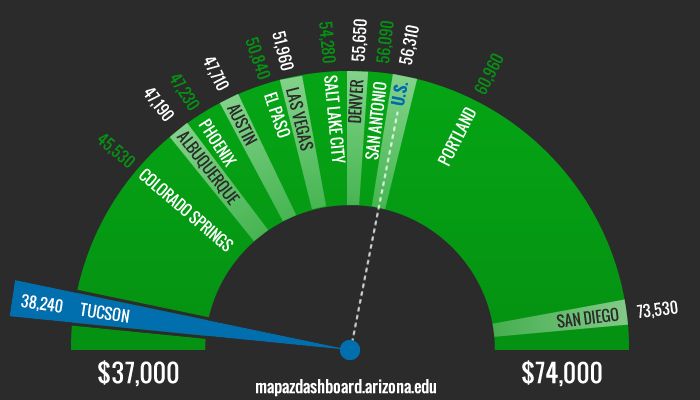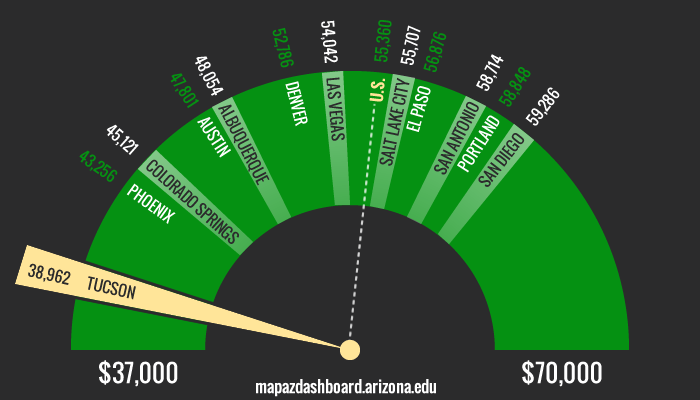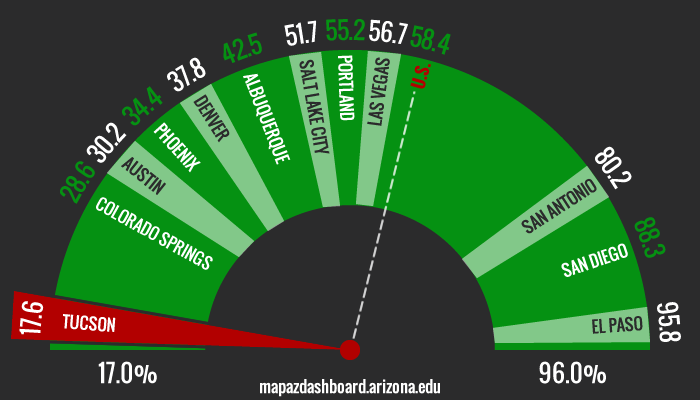Elementary, middle, and secondary school teachers in the Tucson MSA all earn significantly less than their peers in the state and nation. In this article, we will focus on secondary school teacher wages. To learn more about the wages for elementary and middle school teachers visit the Teacher Wage indicator. As Exhibit 1 shows, secondary school teacher wages were $38,240 in 2014. Of the 12 metropolitan areas tracked on the Making Action Possible (MAP) Dashboard, Tucson ranked dead last. Additionally, wages for secondary school teachers in the Phoenix MSA were also well below the nation. San Diego had the highest wage at $73,520, while secondary school teachers in Portland earned the second highest wage at $60,960.
Exhibit 1
Median Annual Wage for Secondary School Teachers (2014)

Does the cost of living in Tucson justify the low teacher wages? Likewise, how do secondary school teachers in San Diego and Portland fare once wages have been adjusted for their region’s high cost of living? Exhibit 2 shows secondary school teacher wages after adjustment for the local cost of living. As one would expect, wages for secondary school teachers when adjusted by the cost of living move closer to the U.S. level. Nonetheless, San Diego’s secondary school teacher wages remain in first place, followed closely by Portland. Tucson on the other hand, has a cost of living slightly less than the nation. When secondary school teacher wages in Tucson are adjusted for the cost of living they only inch slightly closer to the U.S., and remain in last place. In terms of cost-of-living adjusted wages, secondary school teachers are better off in all of Tucson’s peer metropolitan areas.
Exhibit 2
Secondary School Teacher Wages Adjusted
for the Cost of Living (2013)

In 2014, secondary school teachers earned more than the median wage earner for all occupations in the Tucson MSA, $38,240 versus $32,510, a 17.6% difference. It is important to keep in mind that the median wage for all occupations reflects both low and high skilled workers, with a large number of occupations requiring little education. In contrast, nearly all secondary school teachers have at least a bachelor’s degree and many have a graduate degree. Thus, we would expect secondary school teachers to earn more than the median for all occupations. As the fuel gauge below (exhibit 3) shows, Tucson MSA secondary school teachers earned 17.6% more than the median wage earner. However, this gap was far smaller than we find for any other metropolitan area tracked on the Dashboard, as well as the national average. Note that secondary school teachers in the El Paso metropolitan area earned nearly twice as much as the median occupation.
Exhibit 3
Secondary School Teacher Wages Relative to
the Median for All Occupations (2014)

Teacher wages are important to a region’s economic and social well-being. Research has shown that providing competitive wages for teachers has a significant effect on the decision to choose teaching as an occupation. Additionally, insufficient compensation for teachers, in relation to other occupations, may affect turnover rates. As the data above has illustrated, secondary school teachers in Tucson are paid substantially less than their peers in several metropolitan areas around the western U.S.













